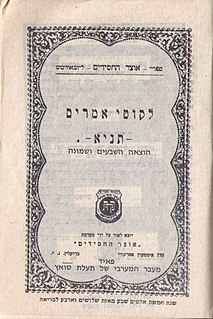 W
WBahir or Sefer HaBahir is an anonymous mystical work, attributed to a 1st-century rabbinic sage Nehunya ben HaKanah because it begins with the words, "R. Nehunya ben HaKanah said". It is also known as Midrash of Rabbi Nehunya ben HaKanah מִדְרָשׁ רַבִּי נְחוּנְיָא בֶּן הַקָּנָה.
 W
WA Baraita of Samuel was known to Jewish scholars from Shabbethai Donolo in the 10th century to Simon Duran in the 15th century, and citations from it were made by them. It was considered as lost until around 1861, when it unexpectedly appeared in print.
 W
WHayom Yom is anthology of Hasidic aphorisms and customs arranged according to the calendar for the Hebrew year of 5703 (1942–43). The work was compiled and arranged by Rabbi Menachem Mendel Schneerson, the seventh Rabbi of Chabad, from the talks and letters of the sixth Chabad Rebbe, Rabbi Yosef Yitzchok Schneersohn. The work was published in 1943.
 W
WYosef Hayim was a leading Baghdadi hakham, authority on halakha, and Master Kabbalist. He is best known as author of the work on halakha Ben Ish Ḥai, a collection of the laws of everyday life interspersed with mystical insights and customs, addressed to the masses and arranged by the weekly Torah portion.
 W
WThe Hekhalot literature from the Hebrew word for "Palaces", relating to visions of ascents into heavenly palaces. The genre overlaps with Merkabah or "Chariot" literature, concerning Ezekiel's chariot, so the two are sometimes referred to together as "Books of the Palaces and the Chariot". The Hekhalot literature is a genre of Jewish esoteric and revelatory texts produced some time between late antiquity – some believe from Talmudic times or earlier – to the Early Middle Ages.
 W
WLikkutei Sichos, literally, "Collected Talks" contains both the scope and the core of the teachings of the Lubavitcher Rebbe, Rabbi Menachem Mendel Schneerson, and is the most authoritative source-text for Schneerson's way of explaining Judaism and the world writ large.
 W
WMaamarim/Ma'amorim in Chabad Hasidism are the central format texts of in-depth mystical investigation in Hasidic thought. In Chabad philosophy, the textual format of the Maamar is used in a great number of published works.
 W
WThe Tanya is an early work of Hasidic philosophy, by Rabbi Shneur Zalman of Liadi, the founder of Chabad Hasidism, first published in 1797. Its formal title is Likkutei Amarim, but is more commonly known by its opening word, Tanya, which means "it was taught in a beraita". It is composed of five sections that define Hasidic mystical psychology and theology as a handbook for daily spiritual life in Jewish observance.